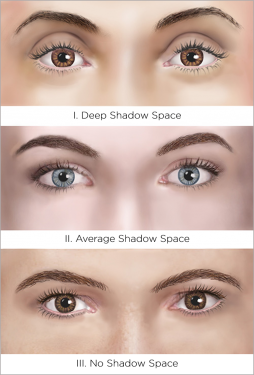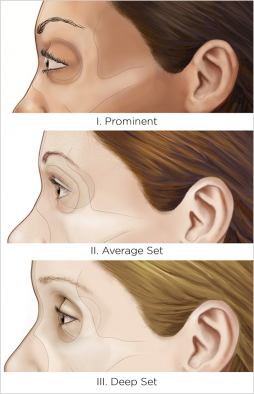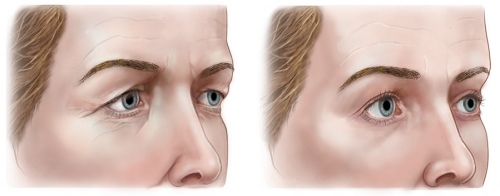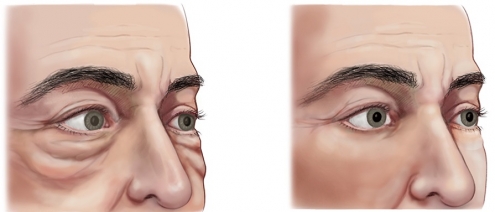"There are many beautiful eye shapes; there is no universal “ideal.” Different eye shapes age differently and require different prescriptions. The cutting edge in eyelid rejuvenation lies in appropriately combining surgical and nonsurgical techniques and in pursuing a “shape-preserving” approach."
The unique look of the eyes is largely determined by each individual's bony anatomy: the shape of the upper eyelids, the position of the eye-ball itself, and the presence or lack of fat around the eyes. Old fashioned blepharoplasties that removed fat, muscle, and skin often ignored anatomical variations and altered the native shape and appearance of the eyes. This can be difficult to reverse.
My "shape preserving approach" to blepharoplasty surgery prevents this alteration by tailoring surgical technique to address each person's natural orbital structure and unique aging pattern.
Aging Eyes

As we age, the skin of the upper and lower eyelids thin and loosen as the supportive collagen and elastin fibers decrease, leading to an overall loss in elasticity. Simultaneously, the thin muscle sheet under the skin also loosens and droops. Fine wrinkles form, altering the skin’s texture, and deeper wrinkles result from repeated muscle action. Fat under the skin, of which there is very little, also decreases leading to further thinning and hollowing. Hollowness, first seen as a circle of mild depression under the eye may deepen over time and create a chronically tired appearance.
Conversely, “orbital fat bags” (fat content in the bony socket around the eyes) increase in size, loosen outward, or both. There are three such pockets of fat in the lower lid and two in the upper lid. These changes results in a baggy look that is usually hereditary.
The thinning of the skin, loss of fat, in some areas, and bulging of the orbital fat pockets, all contribute to the baggy, tired look that comes with age. Surface skin damage, darkening of the skin color, fine and coarse wrinkles, and crow’s feet also contribute to an aged eye appearance.
In the brow area, loss of “fat padding” with age, together with fat loss in the upper lid, and downward pull by the muscles around the eyes, lead to lowering of the brow and heaviness of the upper lid with skin hanging over the lash line creating a “hooded” appearance. In many, however, the upper lid may develop a hollow, sunken look instead. As fat diminishes, the eye’s shape may appear more round than almond.
Priorities: The Shape Preserving Approach
My main and most important objective is to achieve flawless results that preserve (rather than change) the unique look, character, and shape of the eyes.
As part of my shape preserving approach, I request that all candidates provide photos of themselves in their 20's and 30's that clearly show the original shape of their eyes and eyelids. These photos allow me to trace, and appropriately reverse, age-related changes while staying true to the original "blue print." The exception to the shape preserving approach arises when a patient specially wishes to change the shape and character of their eyes.
Shape Preserving Approach: Four Considerations
1. Upper Eyelid Shape:

The shape of the upper eyelid determines the “look” or character of the eyes to a large extent.
There are different upper eyelid shapes, from deep shadow space, to average shadow space, to no shadow space showing, and they are all beautiful. Surgery should preserve this unique shape, which was not always considered with past surgical techniques.
2. Eye Shape & Position:
There are different eye shapes and globe positions, from prominent/poppy eyes, to average set, to very deep-set. They age differently and they must be treated differently to preserve the apparent look and shape of the eye overall.
For example, when treating prominent, protuberant eyes, it is not advisable to remove a large amount of fat or skin from around the eye because it can cause the eye to appear rounder and more orb-like.
3. Lower Eyelid Support: The shape of the eye can be ensured by using a special suture called a canthopexy. This suture prevents muscle and skin from weakening and moving over time, which can cause shape change. Think of it as a shape preserving insurance suture.

4. Volume Preservation: Volume preservation is a shift in paradigm in eyelid surgery. Removing too much or too little fat can alter overall appearance.
During your consultation:
- Review photos taken of you over a period of years and discuss your goals
- Discuss your unique aging pattern and how aging might impact the outcome of your eyelid lift
- Discuss the appropriate plan and other adjunct procedures that might be indicated for the best outcome.
- There will be particular focus on how to combine surgical and non-surgical techniques for the best and most invisible results
Hirmand Technique
UPPER EYELIDS:

For the upper eyelid, the aesthetic planning and the markings that accompany that plan for a “shape preserving blepharoplasty” are the first and most important steps. There are different shapes to the upper eyelid; some have always had a deep shadow space and some have very full lids with the shadow space barely exposed. Others have an oblique slant to the way the upper lid folds. My focus is to maintain the shape and thus the “look’ of the eye.
A small incision is made along the natural fold of the eyelid. The loose skin is meticulously removed leaving as much fat and muscle intact as possible to preserve and enhance the natural fullness of the eye. This is in contrast to traditional blepharoplasties during which fat and muscle is routinely removed. In some cases, conservative treatment of the bulging fat pocket near the nose helps contour the shape effectively. Using ultra fine sutures diminishes the scarring and often makes the final scar imperceptible.
Of note, the frown muscle causing the “11’s” between the brows can be weakened surgically at the same time as the upper blepharoplasty.
LOWER EYELIDS:
For the lower eyelid, fat is removed or repositioned in the lower eyelid depending on the size of the bags, extent of hollowing, and the overall condition of the skin. In addition, crepy lower eyelid skin can be improved by excising loose skin and tightening the muscle. An important component of shape preserving blepharoplasty in some is a canthopexy—a procedure that tightens the tendon supporting the lower eyelid. This particular procedure, when needed, and performed with precision, will effectively prevent the shape of the eye from changing.

In many instances, when fat bags are the only issue, without significant skin looseness, fat can be contoured through small hidden incisions inside the lower lid with no visible external scars (Transconjunctial Blepharoplasty). This is usually a great solution for the younger person with familial fat bags and is a more limited procedure with faster recovery. In these individuals, it is clearly advantageous to do the procedure at a younger age, and before skin looseness set in.
In both upper and lower eyelid rejuvenation, extra volume may be introduced to correct volume loss that has occurred over time. This could be in the form of fat grafting at the time of the blepharoplasty or later, or more commonly by injection of newer fillers such as hyaluronic acids (read more on Tear Trough and Microbeading procedures).
I perform all blepharoplasties under magnification and use corneal protectors for safety.
Surgical notes
Anesthesia: local or general depending on the procedure
Length of surgery: 1-3 hours
Outpatient/inpatient: outpatient
Adjunct procedures: upper and/or lower lid, browlift, facelift
Recovery: 2 weeks